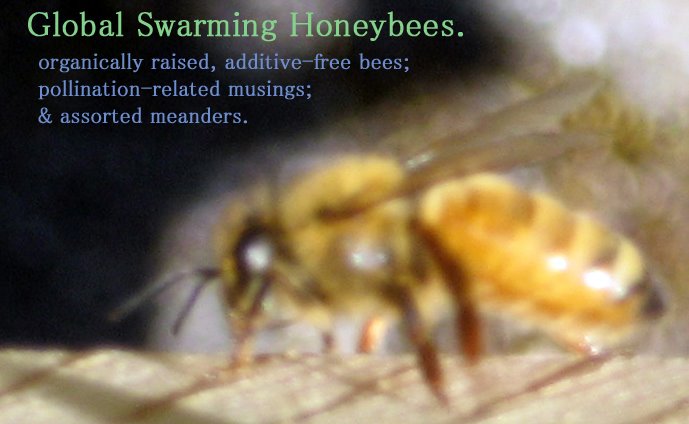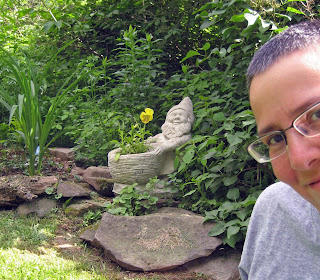Warning: If you do not wish to see my septic tank, read no further!
 A couple of weeks ago, our ancient septic system of unknown whereabouts began to act up. Quick as a whistle, Mr. Rooter was on the scene, and before long, earth-moving machines had arrived to dig about the lawn in search of said septic device.
A couple of weeks ago, our ancient septic system of unknown whereabouts began to act up. Quick as a whistle, Mr. Rooter was on the scene, and before long, earth-moving machines had arrived to dig about the lawn in search of said septic device. Using interesting high-tech methods, Mr. Rooter actually narrowed down the location fairly quickly. The cement, 1,000-gallon tank (which had not been excavated since who-knows-when) was revealed, pumped, and repaired where a broken pipe was creating technical difficulties resulting in ominous sound effects emanating from sundry plumbing fixtures, shaving years off my life with each and every resentful burble.
Using interesting high-tech methods, Mr. Rooter actually narrowed down the location fairly quickly. The cement, 1,000-gallon tank (which had not been excavated since who-knows-when) was revealed, pumped, and repaired where a broken pipe was creating technical difficulties resulting in ominous sound effects emanating from sundry plumbing fixtures, shaving years off my life with each and every resentful burble.
 After the job was done, a large tract of dirt was left in its wake, a sort of surface-level, Turin-like effigy of the septic tank itself. At the stern instruction of my Lawn Guy, Jerry, who brooks no interference with the health of our lawn, Wren and I purchased a small sack of grass seed at the local Agway.
After the job was done, a large tract of dirt was left in its wake, a sort of surface-level, Turin-like effigy of the septic tank itself. At the stern instruction of my Lawn Guy, Jerry, who brooks no interference with the health of our lawn, Wren and I purchased a small sack of grass seed at the local Agway.
The other day, after much procrastinating, I finally got around to sprinkling the seed on the now hard-as-rock ground, raked it in (not really), and then covered it (sort of) with a light layer of hay, as per the Lawn Guy's directive.
I did this all half-heartedly because: (a) I don't really care about the lawn; (b) I don't think terribly well of lawns as an ecological proposition, but am too lazy to painstakingly rake leaves off a moss garden once a week or plant a million shrubs in its place; and (c) I have a trillion other outdoor projects to attend to. But the Lawn Guy told me to do it, and I never mess with the Lawn Guy.
 Fortunately, I had plenty of hay on hand. I use it to build compost piles, mulch the asparagus, and put the various vegetable beds "to sleep," covered and safe from weeds, for the winter. Last winter, I made windbreaks for the beehives using "walls" of hay bales, which I subsequently recycled back into garden use. (This winter, in the spirit of experimentation, I'll try burlap windbreaks instead—an idea proposed by Beekeeper Andrew during his visit).
Fortunately, I had plenty of hay on hand. I use it to build compost piles, mulch the asparagus, and put the various vegetable beds "to sleep," covered and safe from weeds, for the winter. Last winter, I made windbreaks for the beehives using "walls" of hay bales, which I subsequently recycled back into garden use. (This winter, in the spirit of experimentation, I'll try burlap windbreaks instead—an idea proposed by Beekeeper Andrew during his visit).
The truth is, I love playing with hay. For one thing, I adore the smell. It reminds me of being a kid at farm camp and jumping into mounds of soft, dry, sweetly aromatic hay in the Pennsylvania hayloft, as August light eked through the slatted barn beams and Richard Nixon resigned. Happy memories!
I also love playing with hay because it's full of fabulous life forms that, in hauling, disassembling, and redistributing the bales, I get to commune with. For example, after unloading my first bale from the wheelbarrow, I met these cool spiders.


 What kills me about this last arachnid (below) is how well it camouflages with the wheelbarrow! Talk about being ready for anything.
What kills me about this last arachnid (below) is how well it camouflages with the wheelbarrow! Talk about being ready for anything.
 Spiders rock, but nothing floats my boat like a good snake. Again, youthful memories of pet snakes—green grass snakes, garter snakes—and of catching snakes. I was the best at that. Still am.
Spiders rock, but nothing floats my boat like a good snake. Again, youthful memories of pet snakes—green grass snakes, garter snakes—and of catching snakes. I was the best at that. Still am.
I didn't have to catch this one, though. S/he was found slithering around in the wheelbarrow after I removed one of the bales. A lovely garter snake. Haven't seen many this summer; too cool and damp. They're out there, of course, but they're keeping a low profile.
 Between sections of the first bale (these segments being referred to, interestingly enough, as "books"), I found this exquisite young red-bellied snake. I'd never even heard of red-bellied snakes before coming here, but I now encounter them quite often. They are delicate, gentle, shy, and gem-like. I love everything about them.
Between sections of the first bale (these segments being referred to, interestingly enough, as "books"), I found this exquisite young red-bellied snake. I'd never even heard of red-bellied snakes before coming here, but I now encounter them quite often. They are delicate, gentle, shy, and gem-like. I love everything about them.
 Both snakes (along with all the spiders) were carefully returned to the hay bale pile, but before doing so, I couldn't resist snapping this glamorous closeup.
Both snakes (along with all the spiders) were carefully returned to the hay bale pile, but before doing so, I couldn't resist snapping this glamorous closeup.
 Check out that two-toned tongue. Snakes use their tongues not only to taste and touch, but also as a scenting device. It seems the forked tongue allows the snake to determine from which direction a given scent—whether prey, mate, predator, or anything else of interest—is coming from.
Check out that two-toned tongue. Snakes use their tongues not only to taste and touch, but also as a scenting device. It seems the forked tongue allows the snake to determine from which direction a given scent—whether prey, mate, predator, or anything else of interest—is coming from.
Having finished my reverie amongst the snakes and spiders, I found my attention grabbed anew by the subtle, intricate beauty of the cut, dried, and compacted grasses and other herbaceous material that populate a bale of hay.  It's the ultimate still life: a segment of field pressed like a flower in a book—a book that tells the history of a meadow at summer's pinnacle—a book that looks, thinks, and smells like hay.
It's the ultimate still life: a segment of field pressed like a flower in a book—a book that tells the history of a meadow at summer's pinnacle—a book that looks, thinks, and smells like hay.






















No comments:
Post a Comment